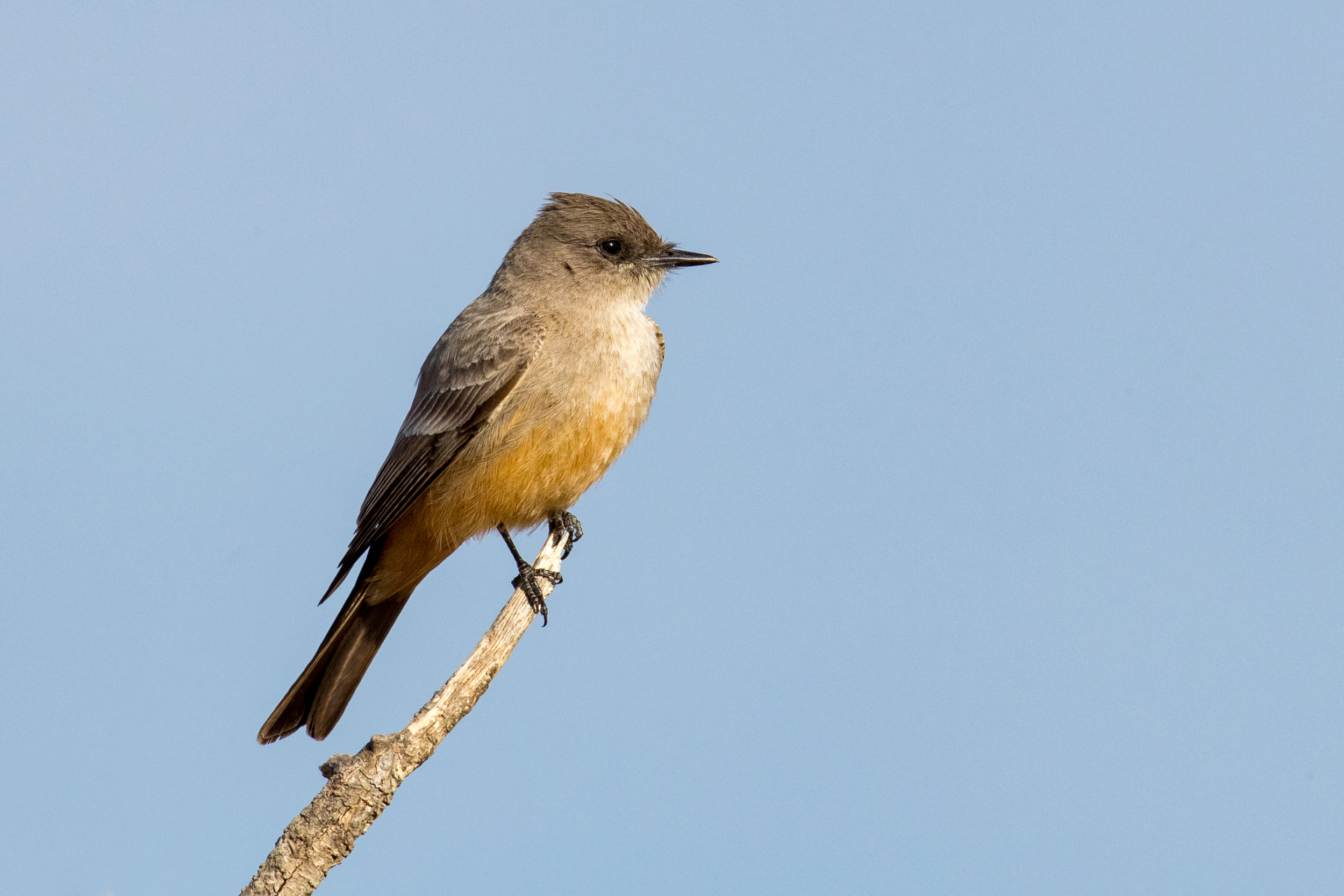Gallery - Warblers and Flycatchers
The Black Phoebe has been expanding its range northward and in recent years has been breeding in a few places in Washington west of the Cascades.
Darting from its perch on the wire a Western Kingbird gives chase to a bee that has just entered its territory. It takes a few yards for the kingbird to catch up to the bee but with a click of its bill the bird has secured its lunch and returns to its perch.
Originally found near Nashville, TN in 1811 by Alexander Wilson the Nashville Warbler is found in nearly every state, but does not breed anywhere near Nashville (Kaufman). It was once considered rare, probably because the eastern half of the U.S. was more heavily forested at the time.
The Yellow Warbler is aptly named for it is the most yellow of all North American wood warblers. The male has a bright, unmarked, yellow face and yellow throat and under parts. It is the only wood warbler with yellow spots in the tail. From below the tail and under tail coverts are entirely yellow. The male has red streaks on its chest, although this feature is quite variable. Its dark black eye is prominent and beady.
The Orange-crowned is a medium-sized warbler with an olive-green back and a yellow-green chest marked by indistinct gray streaks. There is a dusky gray stripe through the eye. The undertail coverts are brighter yellow. There are no wing bars or other distinctive marks on its plumage. In short, the bird is, “Striking in its plainness” (Gilbert, et al).
As with many of our western birds this warbler is named after human beings. John James Audubon named it in honor of the Scottish ornithologist Wiliam MacGillivray who authored the 5-volume History of British Birds (1837-1851). However, it was later learned that John Townsend (of Townsend’s Warbler and Townsend’s Solitaire) had named it for William Tolmei, a physician who worked for Hudson Bay Company.
The Palm Warbler is one of Washington’s “Winter Warblers.” In late fall and winter, with numbers varying considerably each year, Palm Warblers migrate south along the Pacific Coast through Washington, Oregon and California. In recent years Palm Warblers have been seen in Ocean Shores and on the Seattle campus of the University of Washington.
The Black-throated Gray Warbler is a specialty species of the western United States and British Columbia. Its bold black and white coloration gives it a unique look among western warblers and makes it fairly easy to identify.
Formerly listed as two separate species, Myrtle Warbler S.c.coronata in Eastern North America and Audubon’s Warbler S. c. auduboni in the west, the Yellow-rumped Warbler is the most widespread and most common warbler in North America.
The Hermit Warbler is considered a specialist in living in the canopy of 200 foot tall conifers. In western Washington it populates Douglas firs, western hemlocks, and western red cedars. It winters in pine-oak forests in Mexico and in California it enjoys Jeffrey, pondersosa, and lodgepole pines. It forages so high that it is often heard long before it is seen.
In perpetual motion flashing wings and tail the American Redstart is a joyous bird. Males are black with orange patches on wings and tail, and females are gray with yellow patches.
Wilson’s Warbler is often found along wooded streams, in low shrubs, willows and alders (Kaufman). It sings loudly and regularly and can lead a birder trying to see it on a frustrating chase through dense underbrush, but persistence will pay off with a view of this lovely bird. Its song is more of a descending chatter chi chi chi chi chi chet chet, than a song.
A bird of open woodlands, the Western Wood-Pewee is widespread in the western United States as far east as the western side of the plains states. It is most often seen calling pee-er from an open branch from which it will also sally forth to catch a variety of insects including flies, bees, wasps, beetles, moths and bugs (Bemis & Rising).
This boldly patterned warbler is a Pacific Northwest specialty that inhabits our coniferous forests. Townsend’s Warblers are a bright spot in the northwest’s gray winters and welcome visitors to the lowlands. They can occasionally be seen at suet feeders to the delight of backyard birders.
In North America, the Willow flycatcher inhabits more southern and western areas than its close relative, the Alder flycatcher.
This bird of summer is often seems in need of refreshment and loudly calls out QUICK, THREE BEERS. Its indulgence makes it a favorite of birders and provides a readily identifiable bird song.
Say’s Phoebe is an early migrant often arriving in Washington in late March, before any other flycatcher. It is a bird of open, dry, western country and can be seen perched on wires, boulders and fences, or simply low vegetation.
Hammond’s is a common western flycatcher which prefers shady forest areas under a closed canopy.
The Pacific-slope Flycatcher was formerly considered the same species as the Cordilleran Flycatcher Empidonax occidentalis and known as the Western Flycatcher.
“Abundant and well-known, the Common Yellowthroat has succeeded by being a nonconformist. As the only one of our warblers that will nest in open marshes, it is found in practically every reed-bed and patch of cattails from coast to coast” (Kaufman, p. 550).




















